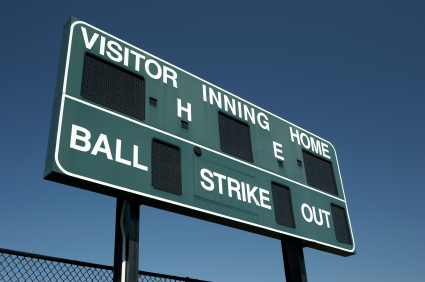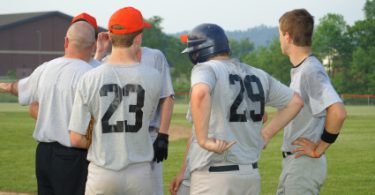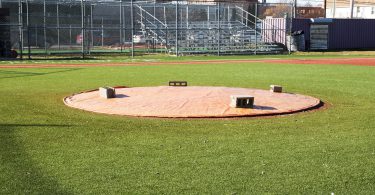Even as the game’s understanding of how to best use different kinds of bunts to generate offensive production shifts, bunting can be a great equalizer in the amateur game. In general, at the college level (and any level below it), bunts are poorly defended. As such, being able to get a bunt down or bunt for a base hit will always make a player and team more difficult to defend. Even if your players can knock the ball out of the yard, having the bunt be part of their skill set will make them a better and more versatile offensive weapon. If they need it, it’s there and the defense must account for it. Even #NeverBunt-ers and pro baseball purists would struggle to deny the value of the bunt as an offensive weapon in the amateur game. As such, this article explains why we’ve been teaching the bunt all wrong and describes a different approach to teaching the bunt.
Discovering A Better Way To Bunt: How I came to believe that typical bunting instruction is flawed
Growing up in baseball on the west coast, the bunt was always a big part of the offensive game. As I progressed from Little League to Pony League to High School and beyond, the fundamentals of the bunt and bunting practice always seemed to be some variation of the same instruction manual passed down from one coaching generation to the next. Square with your chest to the pitcher, get the bat out front of your body at eye level, pinch the bat here, bend at the knees, work from the top of the strike zone, and use the bat to deaden the ball.
Bunt training also seemed to originate from the same coaching manual. Cones were set up down the line and the goal was to get the ball between the cones, ideally coming to a rest on a dollar bill or other marker that represented the perfect, indefensible placement. I tacitly accepted this as the way to teach and practice bunting, until a 2-year coaching stint in the Pac 12. I worked our daily bunt station at Cal regularly, but it was patterns I noticed in the bunts laid down by our Pac 12 opponents that served as the impetus for what I believe is a more simple way to teach the bunt. A weekend series against Oregon State in Corvallis set the light bulb off.
That weekend, our pitchers struggled to field and get outs on several similar bunts, and not bunts that would generally be considered well-placed bunts, either. The bunts hit the turf within a foot or two of the front of home plate and chopped in the air towards the mound. Several shared characteristics about the play caught my attention. The bunts rushed our pitchers despite being towards the mound, when caught in-between hops, our pitchers always opted to wait for an extra bounce and easy long hop rather than go get the short hop, and the runners on base got outstanding jumps because of the easy down-angle read off the bat. After reflecting and watching a similar pattern of bunts play out repeatedly throughout the season, I developed a new thought process on how to evaluate the success of a bunt and how we should teach bunting.
In the remainder of this article, I will present the foundation for creating a thoughtless bunter and explain why it is better than traditional bunt teachings, which fill hitters’ heads with mechanical thoughts and give them a task they don’t completely control. In A Better Way to Teach Bunting Part 2, I will go in-depth into these ideas and share how to implement this bunting philosophy with your team.
The Measure of a Successful Bunt: Controlling the First Bounce
The task of the bunter is to control the location of the first bounce of the ball on the ground after making contact with the bat, something they have complete control over. Typically, the hitter will want the first bounce to land in a designated area (think Hula Hoop) approximately 12-18 inches in front of home plate towards the appropriate side of the field for the ultimate goal. It’s important to note that the desired location of the first bounce may not always be in the same and as an inexact science, coaches should get creative and experiment with what works best for their team or have multiple ideal first bounce circles.

The 3 Objectives of First Bounce Bunting
The goal of first bounce bunting is to simplify and give players complete control over their task or goal, simplify the way coaches teach the bunt so hitters approach bunting with the right mindset, and improve the feedback loop for players for all training environments.
- Simplifying the Bunter’s Task: Placement (of the first bounce) is everything
- Simplifying the Teach: Creating “Thoughtless” Bunters by Replacing Mechanics with Mindset
- Simplifying Player Feedback: Creating a Quicker and More Effective Feedback Loop for Any Training Environment
10 Reasons Why First Bounce Bunting is Better than Traditional Final Placement Teachings
- We have been giving bunters a task they ultimately don’t control (final placement of the ball). We should replace this task with one that the bunter has complete control over (the location of the first bounce after contact with the bat), eliminating factors out of their control (spin, field conditions, weather, etc).
- Being a quality bunter is a mindset, not a product of perfect bunting mechanics. Coaches should talk about bunting mechanics only when necessary.
- Like hitting, we should not coach the athleticism and comfort out of bunting stances and mechanics by using cookie cutter instruction or a one-size-fits-all bunting mechanics. Give your players freedom to get into a relaxed, comfortable position where they can cover the strike zone and put themselves in a position to see the ball well. Like hitting, we want to make bunting as thoughtless in the box as possible.
- Deadening the ball with the bat is an advanced skill that makes bunting exponentially harder. The ground will deaden the ball for the hitter if they control the location of the first bounce.
- Pitchers prefer bunts that are rolling to bunts that are chopping or bouncing and most will try to attack the ball so they get a convenient hop, allowing the runner more time to get down the line.
- When the ball contacts the dirt in the desired first bounce space, side spin becomes a non-factor.
- When the task is controlling the location of the first bounce, the hitter will automatically work on top of the ball, eliminating bunt pop-ups.
- When training, the location of the first bounce provides the hitter with immediate feedback as to whether they accomplished the task successfully. This makes results easier to track and adjustments easier to comprehend.
- A ball that is chopping towards the defense doesn’t get to the defender as fast as a ball that is rolling, creating more pressure and urgency for the defender to make a quick exchange and strong throw.
- Baserunners will have an easy down-angle read and get a better jump when the task is controlling the first bounce.
In A New Way to Teach Bunting Part 2, we go in-depth about the rationale behind the first bounce approach to bunting and describe how to implement it into the team setting. Part two also includes a detailed explanation of the three objectives of first bounce bunting listed above, as well as drill suggestions for implementation. Check out Part 2 HERE.







